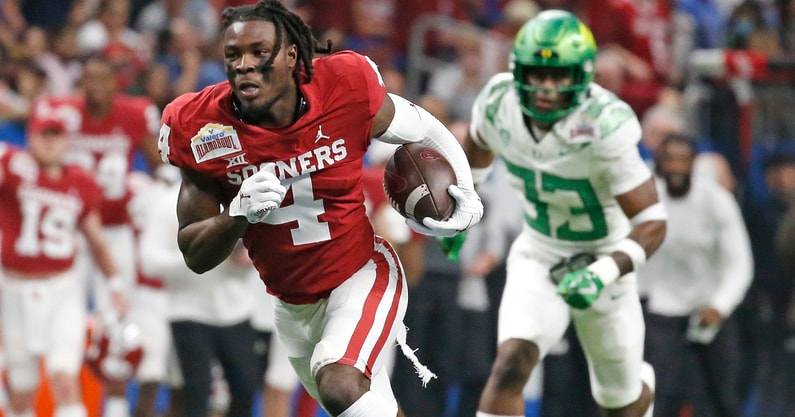Oklahoma wide receiver opens up on decision to enter NCAA Transfer Portal

Oklahoma lost one of its most talented young players to the NCAA Transfer Portal on Tuesday, as Mario Williams announced his intentions to test the waters — and shortly afterwards, he explained why.
Williams just finished up his freshman year with Oklahoma and showed glimpses of his big-play abilities, averaging 16.5 yards per reception. He finished the season with 35 receptions for 380 yards and four touchdowns, and he was named a true freshman All-American by ESPN. Williams just seemed to get better down the stretch of the season, and that was in large part thanks to his chemistry with quarterback Caleb Williams, who did not enter the conversation until the middle of the season. Williams also entered the NCAA Transfer Portal yesterday.
When the 5-foot-9, 186-pound wide receiver entered the NCAA Transfer Portal just one day after Williams, many thought it couldn’t be a coincidence. And in an exchange with On3’s Hayes Fawcett, Williams confirmed that.
“I don’t know what (Caleb Williams is) going to do, but I know I want him to be my QB,” Williams told Fawcett.
Williams was a four-star wide receiver recruit via the On3 Consensus, a complete and equally weighted industry-generated average that utilizes all four major recruiting media companies, making him the No. 3 ranked wide receiver and No. 8 overall recruit out of Florida. The 19-year-old of Plant City, Florida first committed to Oklahoma on Feb. 2, 2021.
More on the Transfer Portal after Williams’ entry
The NCAA Transfer Portal, which covers every NCAA sport at the Division I, II and III levels, is a private database with names of student-athletes who wish to transfer. It is not accessible to the public.
The process of entering the portal is done through a school’s compliance office. Once a player provides written notification of an intent to transfer, the office enters the player’s name in the database and everything is off and running. The compliance office has 48 hours to comply with the player’s request and that request cannot be refused.
Top 10
- 1Hot
National Letter of Intent axed
The NCAA eliminates National Letter of Intent
- 2New
Quinn Ewers
Texas injury report ahead of Red River
- 3
Georgia suspends Colbie Young
Kirby Smart announces indefinite suspension for Georgia WR
- 4Trending
Transfer Portal change
NCAA D-I Committee shortens college football, basketball transfer portal from 45 to 30 days
- 5
Cam Newton
ESPN hires former Auburn QB as regular on 'First Take' with Stephen A. Smith
Once a player’s name shows up in the portal, other schools can contact the player. Players can change their minds at any point and withdraw from the portal. However, once a player enters the portal, the current scholarship no longer has to be honored. In other words, if a player enters the portal but decides to stay, the school is not obligated to provide a scholarship anymore.
The database is a normal database, sortable by a variety of topics, including (of course) sport and name. A player’s individual entry includes basic details such as contact info, whether the player was on scholarship and whether the player is transferring as a graduate student.
A player can ask that a “do not contact” tag be placed on the report. In those instances, the players don’t want to be contacted by schools unless they’ve initiated the communication.
The portal has been around since Oct. 15, 2018 and the new calendar cycle within the portal begins each August. For example, the 2021-22 cycle started Aug. 1. During the 2020-21 cycle, 2,626 FBS football players entered the transfer portal (including walk-ons). That comes after 1,681 entered during the 2019-20 cycle and 1,709 during the abbreviated 2018-19 cycle. In comparison, 1,833 Division I basketball players entered the portal during the 2020-21 cycle after totals of 1,020 in 2019-20 and 1,063 in 2018-19.